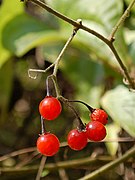Comments
provided by eFloras
Stems can be used as a medicine for treating convulsions in infants, and branches and leaves for clearing away heat and cooling the blood.
- license
- cc-by-nc-sa-3.0
- copyright
- Missouri Botanical Garden, 4344 Shaw Boulevard, St. Louis, MO, 63110 USA
Description
provided by eFloras
Vines herbaceous, much branched, 0.5-3 m tall, villous overall with elongate, many-celled hairs more than 2 mm. Petiole 1-3 cm; leaf blade elliptic or lyrate, 3-11 × 2-6 cm, base cordate or hastate, margin entire or 3-5-parted, apex acuminate. Inflorescences axillary, extra-axillary, or appearing terminal, few- to many-flowered panicles; peduncle 2-4 cm, villous. Pedicel 0.8-1.5 cm, villous. Calyx 1.5-2.5 × 3-4 mm in diam., sparsely pubescent; lobes rounded. Corolla blue-purple or white, 5-8 × 10 mm; lobes elliptic-lanceolate, ca. 4 × 2 mm, usually reflexed, puberulent at apex. Filaments ca. 0.8-1 mm; anthers free, oblong, 2.8-3.2 mm. Style glabrous, 6-8 mm. Fruiting pedicel sparsely pubescent, usually curved. Berry red or red-black, globose, 7-9 mm in diam. Seeds discoid, ca. 1.5 mm in diam., reticulate. Fl. Jun-Oct, fr. Oct-Nov.
- license
- cc-by-nc-sa-3.0
- copyright
- Missouri Botanical Garden, 4344 Shaw Boulevard, St. Louis, MO, 63110 USA
Distribution
provided by eFloras
Anhui, Fujian, Gansu, Guangdong, Guangxi, Guizhou, Hainan, Henan, Hubei, Hunan, Jiangsu, Jiangxi, Shaanxi, Shandong, Shanxi, Sichuan, Taiwan, Xizang, Yunnan, Zhejiang [Cambodia, Japan including Ryukyu Islands, Korea, Laos, Myanmar, Thailand, Vietnam.]
- license
- cc-by-nc-sa-3.0
- copyright
- Missouri Botanical Garden, 4344 Shaw Boulevard, St. Louis, MO, 63110 USA
Habitat
provided by eFloras
Grasslands in valleys, near roads and fields; 100-2900 m.
- license
- cc-by-nc-sa-3.0
- copyright
- Missouri Botanical Garden, 4344 Shaw Boulevard, St. Louis, MO, 63110 USA
Synonym
provided by eFloras
Solanum cathayanum C. Y. Wu & S. C. Huang; S. dulcamara var. chinense Dunal; S. dulcamara var. pubescens Blume; S. dulcamara var. lyratum (Thunberg) Bonati.
- license
- cc-by-nc-sa-3.0
- copyright
- Missouri Botanical Garden, 4344 Shaw Boulevard, St. Louis, MO, 63110 USA
Description
provided by Phytokeys (archived)
Sprawling shrub or herbaceous vine, woody at the base. Stems flexuous, not winged, sparsely to densely pubescent with translucent, glandular, simple uniseriate trichomes to 4 mm long, with 4–6 cells, the gland 1-celled, these overtopping shorter glandular simple trichomes ca. 0.5 mm long, the trichomes weak and tangled; new growth densely pubescent with trichomes like those of the stems. Bark of older stems pale yellowish tan, glabrescent, the longer trichomes usually breaking off and only the shorter ones remaining. Sympodial units plurifoliate. Leaves simple or pinnatifid, usually only with 2 lyrate lobes at the base, 2–6(-9) cm long, 0.5–5(-7) cm wide, cordate to lyrate, widest in the basal third, thin and membranous, both surfaces uniformly pubescent with weak, translucent simple uniseriate trichomes to 4 mm long, these usually glandular like those of the stems; primary veins 5–7 pairs, usually yellowish in dry material; base cordate, occasionally truncate, not decurrent on the petiole; margins entire or lobed, the lobes usually only a pair at the base, these sometimes completely divided and the leaf apparently pinnate, occasionally with up to 4 pairs of lobes; apex acuminate or acute; petiole 1–3 cm long, pubescent like the stems, twining. Inflorescences terminal or lateral, 2.5–10 cm long, open and many times branched, with 10–40+ flowers, usually only a few open at a time, pubescent with simple uniseriate glandular trichomes like those of the stems; peduncle 2–6 cm long; pedicels 7–11 mm long, ca. 0.5 mm in diameter at the base, ca. 1 mm in diameter at the apex, slender and spreading, glabrous or short-glandular pubescent, articulated at the base in a small sleeve 1–2 mm long; pedicel scars irregularly spaced 2–9 mm apart, more congested distally. Buds ellipsoid, the corolla strongly exserted from the calyx tube before anthesis. Flowers all perfect, 5-merous. Calyx tube 1–1.5 mm long, conical, the lobes 0–1 mm long, deltate or mere enations on the calyx rim, glabrous, papillate on the tips. Corolla 8–13 mm in diameter, white to pale lavender, with green and white spots at the base of each lobe, stellate, lobed 3/4 of the way to the base, the lobes 3–6 mm long, 2–3 mm wide, strongly reflexed at anthesis, the tips and margins densely papillose. Filament tube minute, the free portion of the filaments 1–1.5 mm long, glabrous; anthers 3–3.5 mm long, 1–1.5 mm wide, ellipsoid, loosely connivent, often dark blue or black, the base sagittate, poricidal at the tips, the pores lengthening to slits with age. Ovary glabrous; style 5–7 mm long, glabrous; stigma capitate, the surface minutely papillate. Fruit a globose berry, ca. 1 cm in diameter, bright red, translucent and shiny when ripe, the juice staining scarlet; fruiting pedicels 1–1.5 cm long, ca. 0.75 mm in diameter at the base, spreading. Seeds >30 per berry, ca. 2.5 mm long, ca. 1.5 mm wide, flattened reniform, pale yellowish tan, the surfaces minutely pitted, when mature the seed apparently hairy from the elongate lateral testal cell walls, these to 0.5 mm. Chromosome number: not known.
- bibliographic citation
- Knapp S (2013) A revision of the Dulcamaroid Clade of Solanum L. (Solanaceae) PhytoKeys 22: 1–432
- author
- Sandra Knapp
Distribution
provided by Phytokeys (archived)
(Figure 62). Solanum lyratum occurs in a wide variety of habitats in China, Japan and north Vietnam, from sea level to 1500 m.
- bibliographic citation
- Knapp S (2013) A revision of the Dulcamaroid Clade of Solanum L. (Solanaceae) PhytoKeys 22: 1–432
- author
- Sandra Knapp
Solanum lyratum: Brief Summary
provided by wikipedia EN
Solanum lyratum, the lyreleaf nightshade, is a species of flowering plant in the family Solanaceae, native to China, Taiwan, Vietnam, Cambodia, the Korean Peninsula, and Japan. Usually found in forests, it is also somewhat weedy and can be found on disturbed ground.

Flowers

Fruit

In Kobe, Japan

Botanical illustration
- license
- cc-by-sa-3.0
- copyright
- Wikipedia authors and editors





